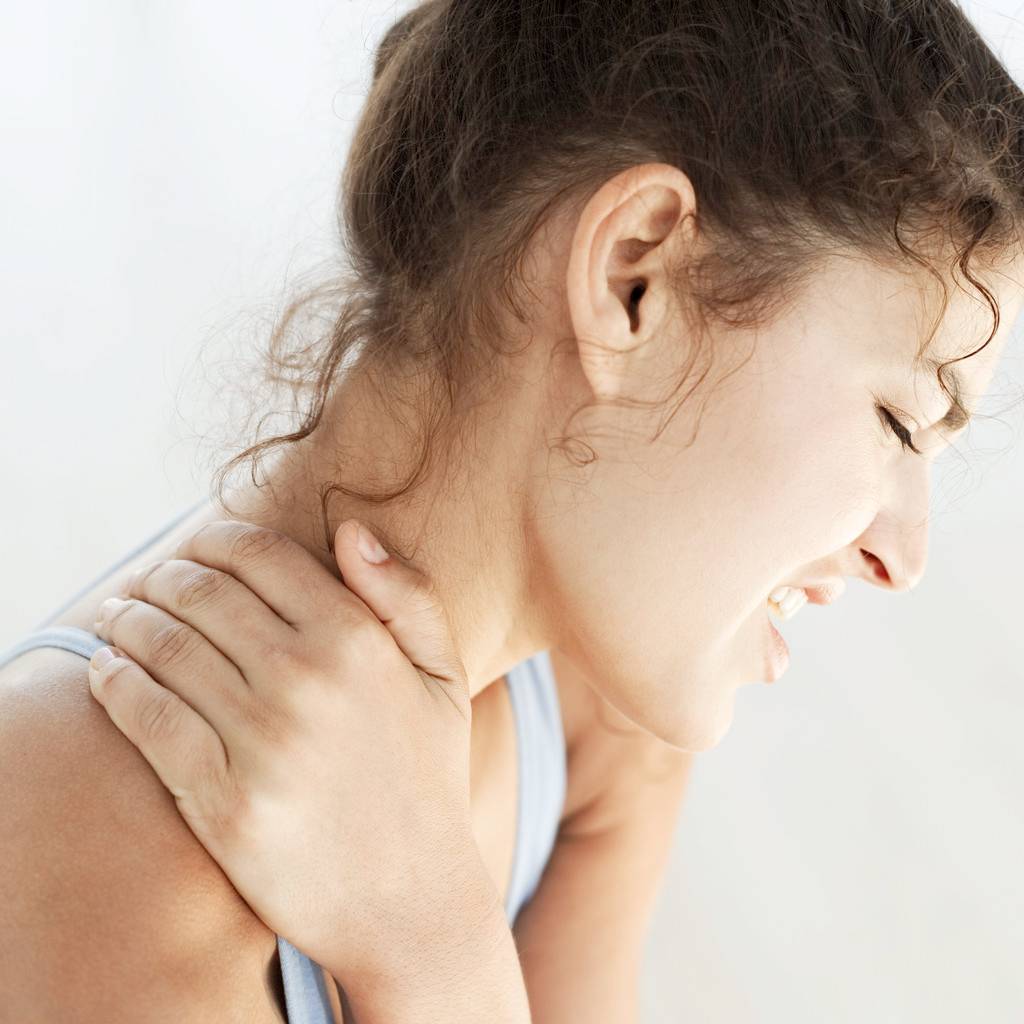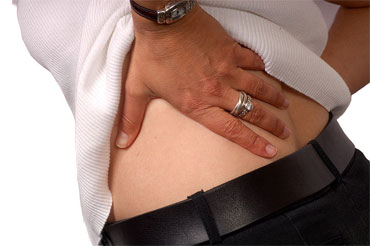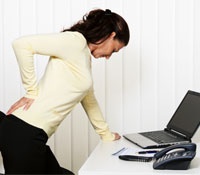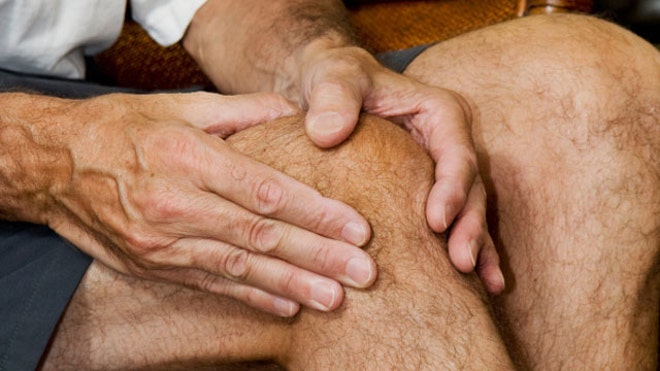
“This job is a pain in the neck” may be more than just a saying. Tension on the job or at home, tasks that require a lot of leaning over a work surface, poor posture, and even a too-soft mattress can cause neck pain and stiffness. Of course, some neck pain is the result of injury or disease, but the vast majority of neck pain is due to simple muscle tension.
The neck, with its intricate structure and wide range of mobility, is particularly vulnerable to stress and strain. The head, which weighs between 10 and 20 pounds, is supported by a stack of seven small bones called vertebrae and held in place by 32 complex muscles.
Attached to and between the vertebrae are pads of fibrous cartilage called discs that act as cushions, or shock absorbers. Eight nerves, which relay sensations (including pain), and four major arteries, which carry blood, run through the neck and connect the head with the shoulders, chest, and arms. The delicate spinal cord runs through the center of the stack of vertebrae and is protected by it. Add to this complex structure the fact that the neck moves more than any other part of the body, and you’ve got a formula for trouble.
It’s a vicious cycle. When our muscles tense, either because of physical or emotional stress, the blood supply to the muscles decreases, causing pain. And that pain causes the muscles to tense further. That’s why the best way to relieve neck pain is to try to eliminate or ease the physical or emotional stress in addition to treating the muscles.
Get rid of that pain in the neck by heeding the home remedies that follow.
Take a load off. One of the simplest ways to relieve the pain is to lie down and give your neck muscles a chance to recover. But don’t use a thick pillow that crimps your neck.
Ice it. Ice effectively numbs pain and decreases inflammation. Put crushed ice in a plastic bag and cover the bag with a pillowcase (a terry towel is too thick to effectively transmit the cold). Apply the icepack to your painful neck for 15 minutes at a time.
Heat it up. Heat increases circulation and can be effective for easing stiff muscles. Use a wet towel or a hot water bottle, or stand in a hot shower. But don’t keep it up for too long. Too much heat can aggravate symptoms and cause more pain. You might even want to try following up your heat application with a few minutes of cold treatment.
Relax. Emotional stress can trigger muscle tension. Pay attention to what stresses you: your drive to work, your rush to get dinner on the table each night, meetings with your boss, and so on. After you’ve identified your common stressors, think creatively about ways to reduce your stress. One way to manage stress is through relaxation techniques, such as progressive relaxation or abdominal breathing.
To perform progressive relaxation, find a quiet place where you won’t be disturbed. Sit or lie down and close your eyes. Then, starting with your head and neck and working down the entire body, consciously tighten, or tense, and then completely release the muscles in the area.
To perform abdominal breathing, sit quietly and take a slow, deep breath all the way into your abdomen; place a hand on your abdomen to feel it expand and confirm you are breathing deeply enough. Then exhale completely, gently sucking in your stomach. Breathe slowly and deeply like this for several minutes (if you do this too quickly, you may begin to hyperventilate).
Other relaxation techniques include meditation, yoga, and exercise. In addition, you may want to develop some of your own methods of relaxation, such as engaging in a hobby or listening to peaceful music. Do whatever works for you.
Use massage. Massage can help ease tense muscles and give temporary relief, and it may help you sleep better. First, take a hot bath or shower to relax the muscles. Then, have your partner use oil or lotion and rub your neck and shoulders using the fingers to apply gentle pressure in small circular motions. Next, have your partner rub your neck and shoulders using firm pressure and long, downward strokes. Don’t forget the chest area. If you don’t have a willing partner, try rubbing your own neck and chest area with oil or lotion for 10 or 15 minutes.
Take a nonprescription pain reliever. Over-the-counter pain relievers such as aspirin and ibuprofen can ease the pain and reduce inflammation. If you can’t take these medications because of allergies, stomach upset, or any other reason, try acetaminophen; it won’t calm inflammation, but it should help relieve pain.
Practice good posture. Posture has more to do with neck pain than people realize. The head and spine balance in relation to gravity. When poor posture pulls the curve of the lower back forward, the upper back curves farther backward to compensate. In response, the neck curves forward, in a strained position.
You can use a wall to help align your body properly and improve your posture: Stand with your back to a wall, heels several inches from the wall. Your buttocks and shoulders should touch the wall, and the back of your head should be close to the wall. Keep your chin level. Now, step away from the wall. Step back and check your position. Try to carry this posture throughout the day.
Get and stay trim. Being overweight strains all of the body’s muscles, including those in the neck.
Strengthen stomach muscles. Just as poor posture and obesity can cause straining of the neck muscles, poor tone in the stomach muscles forces the upper back to curve farther backward and the neck to curve forward. Do exercises such as bent-knee curls (they’re basically sit-ups, but you only lift your head and upper back, rather than your whole back, off the ground) to strengthen abdominal muscles.
Do neck exercises. Two types of neck exercises can help ease and prevent neck pain: gentle range-of-motion exercises and isometric exercises. Apply moist heat to the neck before performing the exercises. Each exercise should be done five times per session, three sessions per day.
Range-of-motion exercises help stretch neck muscles. Sit erect but relaxed. Slowly turn your head to the right as far as you can, hold, and return it to the center. Repeat to the left. Then drop your chin down slowly toward your chest, hold, and relax. Bring your head back up. Now tilt your head toward your left shoulder, hold, and return to the center. Do the same on the right side.
Isometric exercises are performed against resistance but without actually moving your head. Try this routine:
Sit erect and relaxed, hold your hand up to your forehead, and press your forehead into your palm, using your palm to resist the motion.
Place your right hand against the right side of your head, and press your head against your hand (as if trying to bring your right ear to your right shoulder), but use your hand to resist your head’s motion. Do the same on the left side.
Press both hands against the back of your head as you try to push your head backward; resist your head’s backward motion with your hands.
Press your hand against the right side of your face as you try to turn your head to look over your right shoulder; use your hand to resist the turning motion. Repeat, pressing your left hand to the left side of your face as you attempt to look over your left shoulder.
Stay in shape. The stronger and more flexible you are overall, the less likely you’ll suffer from neck pain. Swimming is one of the best all-around exercises for strengthening the neck and back.
Work at eye level. If your neck discomfort comes on toward the end of the workday, chances are good that your workstation or your work habits are causing the problem. People often get “desk neck” from looking down for long periods or from reaching up to work. If possible, always keep your work at eye level. Change the height of your chair, desk, or computer screen; use an upright stand to hold reading material; and use a stepladder, stool, or raised platform instead of reaching up.
Take frequent breaks. Change your body position often, especially if you have to be in a physically stressful position. Get up and walk around at least once an hour.
Unlearn “neck-bashing” habits. Do you crimp the phone between your neck and shoulder? Do you often fall asleep sitting up in a chair and wake with your head tilted way back or your chin to your chest? Do you shampoo your hair in the sink? All of these habits can cause neck strain. Become aware of habits that strain your neck and replace them with neck-healthy ones.
Sleep on a firm mattress. If you wake in the morning with a stiff or sore neck, your mattress, pillow, or sleeping habits are probably the culprit. Use a firm mattress and keep your head aligned with your spine. Don’t sleep on your stomach, since it forces your head up. Avoid pillows that are too thick and firm; try feather or crushed-foam pillows rather than those of solid foam rubber.
As you can see, several of your everyday habits can contribute to neck pain. Take the home remedies listed in this article to keep your neck held high and healthy.
Source: how stuff works
Source: how stuff works










